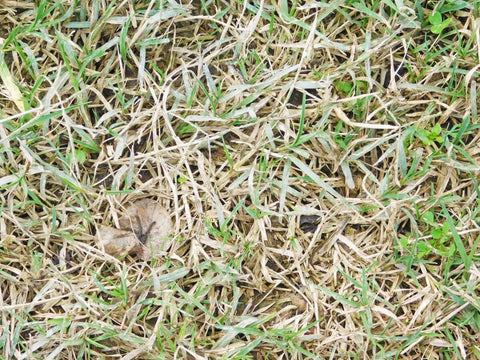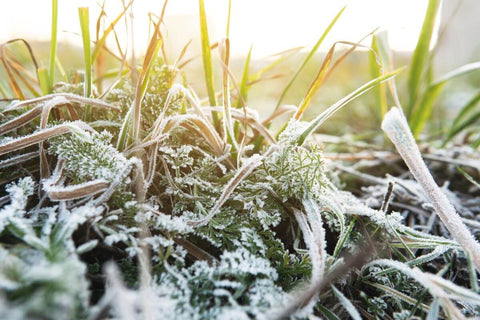Don't let winter steal your lawn's beauty. You can maintain a lush green carpet all year round with a few simple tricks.
In this article, we'll delve into the science behind winter lawn care and provide easy-to-follow advice to help your grass flourish. Let`s begin.
Why You Should Maintain a Green Lawn in Winter
Winter can be brutal on your lawn. Cold temperatures, frost, limited sunlight, and foot traffic create a perfect storm of stress for your grass. Common issues like overwatering, thatch buildup, and nutrient deficiencies further weaken its defenses, leaving it vulnerable to disease and damage.
So, as the experts at the Scotts Company remind us, winter lawn care isn't just about survival – it's about setting the stage for a spectacular spring comeback. A well-prepared lawn is naturally more resilient and better equipped to fight pests, weeds, and diseases that can wreak havoc in the growing season.
Here are additional benefits of maintaining your lawn during winter:
Now that you understand your lawn's challenges in winter let's explore practical solutions that will keep it looking its best.
Keeping Your Lawn Well-Maintained
![]()
Here's a breakdown of the key practices to keep your lawn in top shape during the colder months:
Keep Up with Regular Mowing and Maintain the Right Grass Height
In warm climate regions like Florida or California, regular mowing remains necessary during the cooler winter months.
Turfgrass growth slows in winter due to dry weather, cooler temperatures, and less frequent irrigation. So, on average, lawns should be mowed every two weeks. The frequency varies with your grass growth.
Maintain a higher mow height (around 2.3-5 inches) to protect roots in cooler months.
When in northern regions, look for signs signaling the time to make the last grass cut in the season. The signs include:
- Consistent daytime temps in the 50s, overnight in the 40s.
- The first frost in your region. You can plan for finishing four to five weeks after the frost.
Fertilize Your Lawn
Grass fertilizer provides essential nutrients for dormant lawns.
Fertilizers often are marketed as spring, summer, or fall and winter fertilizers. Usually, summer fertilizers contain a higher proportion of slow-release nitrogen, and winter fertilizers contain more potassium.
Potassium enhances plant health and resilience, especially in winter.
November is a recommended month for fertilizing grass in northen regions.
By giving your lawn this extra boost, you'll aid in its ability to endure the harsh winter conditions.
Keep Those Pesky Weeds Away During the Colder Months
Weeds are more aggressive in colder months when grass is less active.
Did you know that a single weed can produce 100,000 to 200,000 seeds that can survive in soil for 40 years, germinating every spring and fall without fail?
Source: familyhandyman.com
Before winter, implement a weed control program to stop weeds from invading your lawn and depriving it of essential nutrients.
Soil Aeration
Before winter sets in, consider aerating your lawn to boost drainage and oxygenation.
Aeration facilitates the entry of air, water, and nutrients into the root zone by breaking up compacted soil. This process helps your grass grow healthy roots and become more resilient.
Adjust Irrigation Practices
When the temperature drops, be sure to water your lawn appropriately. Overwatering in cold temperatures can cause root rot and fungal diseases.
Watering less often and changing the irrigation schedule based on the weather will keep your grass healthy and stress-free.
Overseed with Cool-Season Grasses
If you see any patches or bare spots on your lawn, consider overseeding with cool-season grass.
These grasses are specially made to thrive in the cold and help fill patchy spots.
To help you visualize these essential winter lawn care tips, we've created a handy infographic summarizing the steps for maintaining a healthy lawn during the colder months.
Download your free copy now and keep it handy as a quick reference guide!
Download 6 Steps for Keeping Your Lawn Well-maintained
Selecting the Right Grass Type for Your Climate
Some grasses are more suited for winter than others. This is what you need to know:
Know Which Grasses Are Good for Winter Weather
Several grass types flourish in winter climates. Two popular choices are:
Kentucky bluegrass: Kentucky bluegrass is the most cold-hardy cool-season grass for northern lawns.
Fescue grass: Fescue grass can withstand low temperatures. Its green color persists in the cold, keeping the lawn vibrant throughout the year.
Consider How Green They Are in Wintertime
Ability to stay green in winter: Seek winter-green grass varieties. It guarantees a vibrant lawn in colder climates.
Adjusting Watering Schedule
Here are some important factors to consider:
Identify Winter Water Requirements for Your Grass Type
Research your grass type's water needs and adjust watering accordingly. Different grasses have varying water needs.
Keep Soil Moisture in Check to Avoid Over or Under-Watering
Moisture levels in the soil are key to a healthy winter lawn.
Don't forget to monitor the moisture levels and avoid over or under-watering. Watering too much can make the roots rot, while not watering enough can dry out your grass.
Use Watering Techniques That Don't Waste Water and Help Roots Grow Deep
Water your lawn in winter using techniques that encourage deep root growth and prevent water runoff.
Water the grass slowly, ensuring the water penetrates the soil and reaches the roots. It promotes a stronger root system for grass during winter.
Protecting the Lawn From Cold Weather
Protect your lawn during winter by taking necessary steps. Here are some winter strategies for green, healthy grass:
Use Mulch or Covers for Grass Insulation
Mulching or using covers can insulate and protect the grass from extreme temperatures.
Mulch serves as a natural barrier, keeping moisture and preventing freezing.
On the flip side, protective covers offer an additional level of insulation and shield the grass from frost and cold winds.
Avoid Snow Mold and Ice Damage With Proper Snow Removal
Winter poses snow mold and ice damage challenges. Employing proper snow removal techniques is crucial for preventing these issues.
- Avoid excessive snow accumulation on your lawn to prevent snow mold.
- Do not use harsh chemicals to melt ice as they can damage the grass. Instead, choose eco-friendly options.
Reduce Grass Damage During Winter Activities
Certain winter activities or events can cause physical damage to your lawn.
- Use caution with heavy machinery on your lawn, like snow blowers. They can harm the grass and cause stress.
- Avoid walking on frozen or snow-covered areas to protect the grass.
Soil Compaction Prevention
- Kindly remind family members and visitors to use alternative pathways instead of walking across the grass.
- Use steppingstones or other surface treatments to divert foot traffic from the lawn.
Winter Pathways to Redirect Human and Pet Traffic
Use gravel, mulch, or wooden boards to create clear pathways. It will redirect traffic and protect the grass.
- Install fences or barriers to limit access to specific lawn areas.
- Teach pets to use specific areas for elimination to preserve the lawn.
Avoiding Chemical Stress
Deicing salts and chemicals used in winter can harm your grass. Recognize potential hazards and minimize their impact.
Potential Negative Effects
- Salt absorbs moisture, causing grass dehydration and root damage.
- Chemicals can change soil pH, hindering grass growth.
- Overusing deicing salts can cause a salt buildup in the soil, hindering nutrient absorption.
How to Minimize Impact
- Limit deicing salts and chemicals near grassy areas.
- Prioritize manual snow and ice removal over chemical methods.
- Opt for sand instead of traditional ice melting products to minimize harm to grass.
- Dilute chemical residue by rinsing grass and nearby plants with water after ice melts.
Managing Shade and Sunlight
Proper shade and sunlight management is crucial for a green winter lawn. Effective strategies include:
Prune Trees or Plants Blocking Sunlight to the Lawn
To allow more sunlight on your lawn, prune shaded trees and overgrown plants.
Sunlight can penetrate and nourish your lawn by trimming back branches and foliage.
Go For Shade-Tolerant Grass Varieties for Less Sunny Areas
Shade-tolerant grass is necessary in shaded areas. These grasses can grow in reduced sunlight and stay green with limited sun exposure.
Some cool-season grasses that can tolerate shade are Tall Fescue and Kentucky Bluegrass.
Monitoring and Treating Common Winter Lawn Issues

In winter, monitor your lawn to prevent and address issues.
Proactive monitoring and treatment maintain green and healthy grass in winter.
These are some key steps for winter lawn issues:
Catch Snow Mold, Winter Diseases, and Pests by Watching Closely
- Regularly check your lawn for snow mold, a common winter disease.
- Look for gray or pinkish snow mold on grass blades and respond promptly if seen.
- Be vigilant for other winter diseases, like red thread or leaf spot. These diseases can discolor and weaken the grass.
If you notice any symptoms, like discolored patches or lesions, seek professional advice if necessary.
- Watch for pests in your lawn, like voles or snow fleas.
Check for tunnels, tracks, or turf damage on the grass. Implement necessary measures to eradicate pests.
Act Promptly to Treat and Reduce the Effects
- Rake areas with snow mold gently to promote air circulation and prevent spreading. Avoid damaging healthy grass.
- Use a recommended fungicide for snow mold control to protect your lawn.
- Adjust your lawn care to treat winter diseases like red thread or leaf spot.
- Enhance drainage, prevent thatch buildup, and avoid excessive watering.
- Consult a professional for pest infestations and determine the best treatment method. Options include insecticides or natural remedies.
Remember, early detection and action are vital for a healthy winter lawn.
Plan for Spring Lawn Care

With winter ending, consider your lawn's needs for spring.
Planning for spring lawn care ensures a smooth transition from winter dormancy to vibrant growth.
Learning Spring Lawn Care for a Smooth Transition From Winter
- Educate yourself on spring lawn care practices for the optimal growth and health. This includes knowing the ideal mowing time, watering frequency, and fertilizing schedule.
- Preparing Soil and Renovating Lawn for Optimal Spring Growth
- Conduct a soil test before spring to assess lawn nutrient levels and pH balance.
- Based on the results, determine if any adjustments are needed for optimal growth.
- Lawn renovation may be needed to address soil compaction and winter weeds.
- Aerate the soil for better drainage and root growth.
- To achieve a fuller and healthier lawn in the spring, consider overseeding any bare or thin areas.
And Wrapping Up!
If you want your lawn to stay green and vibrant during winter, here's what you need to do:
- Properly care for your lawn
- Select the right grass type for your climate
- Adjust your watering schedule
- Protect your lawn from cold weather
- Minimize foot traffic on your lawn
- Avoid chemical stress
- Manage shade and sunlight
- Monitor and treat common winter lawn issues
- Plan for spring lawn care
What's your secret to keeping grass green in winter season? Tell us about your experiences.


